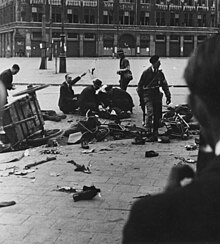Shootout at Dam Square
More than 32 people are believed to have been killed in the shooting on Dam , the central square of Amsterdam , on May 7, 1945. German soldiers shot at Dutch civilians, even though the Wehrmacht had surrendered two days earlier, and there was a gun battle with the inland Strijdkrachten .
The shooting
After the German Wehrmacht surrendered in the Netherlands on May 5, 1945 , two days later thousands of euphoric Amsterdam residents - women, men and children - gathered on Dam Square ; they were expecting the first Canadian soldiers who took part in the liberation of the Netherlands from German occupation . The fair organ Het Snotneusje (the snot nose) played, the people danced and a puppet theater entertained the children.
Around 12:30 p.m., some British military vehicles from the Polar Bear Division reconnaissance unit reached Dam via the Rokin . German trucks came from the opposite direction, and the vehicles passed each other only a few meters apart; a nervous mood arose. The Germans drove on and the British also left the Dam again, waiting for reinforcements. Meanwhile, the Binnenlandse Strijdkrachten (BS) in the city began to disarm German soldiers as part of the Three Castles resistance operation . That was against the surrender agreement, which included that the disarmament of the Germans should be reserved for the Canadian army.
Members of the German navy had holed up in the rooms of the Koninklijke Industrieele Groote Club on Dam Square. From the balcony there, shots were fired at the people on the square at around 3 p.m. and a fire fight broke out between the Germans and the BS. Panic broke out among the people in the square, they ran away in fear or hid behind obstacles such as newspaper kiosks, lampposts or the large organ. More people went to safety in the Nieuwe Kerk .
The firefight lasted about two hours; at least 32 people were killed and many more injured. Nurses , Red Cross members and scouts who were present on site tried to provide the injured people with makeshift care or to move them away. Carel Frederik Overhoff , a commander of the BS, finally succeeded together with a German officer in persuading the two parties to stop the fire. Another version is that the shooting did not end until after bazookas were fired from the Paleis op de Dam in the direction of the Groote Club . The Germans stayed in the club rooms until they were captured by Canadian soldiers on May 9th.
There are films and pictures of the shooting because numerous photographers had come to welcome the Canadians at Dam Square. However, these only reached Amsterdam two days later.
Investigations and memory
The cause and course of the shooting were never investigated, which is attributed to the turmoil after the end of the war. For decades it was therefore unclear how many victims the firefight had caused and who they were; the culprits were never identified either. The cause of the shooting is suspected to be the disarmament of German soldiers by the Dutch BS, contrary to the surrender agreement. The Germans might have felt threatened by the BS and feared the anger of the Dutch. It is possible that the first shots were fired in the area because a German refused to hand over his weapon to the BS.
Initially, up to 22 victims of the shooting were assumed, although newspaper reports at the time reported up to 120 dead. The Stichting Memorial went public in 2015, collected information and held discussions with contemporary witnesses and relatives. By 2016, 32 people who had died on Dam Square in 1945 could be identified; it is unclear whether there were not more fatalities and how many were injured, including those who were run down in panic. The youngest dead was an eight-year-old boy named Gerri.
In 2016, 32 stones with the names of the victims were laid on Dam Square. For the 75th Liberation Day on May 5, 2020, the Het Snotneusje organ was restored. Two bullets that had been in her since the shooting were removed, but the bullet holes were left visible. Due to the COVID-19 pandemic in the Kingdom of the Netherlands , the planned celebrations in 2020 were canceled.
literature
- Flip Bool, Veronica Hekking: De Dam 7 mei 1945. Photos in documents . Primavera Pers, Leiden / Focus, Amsterdam 1992, ISBN 90-74310-04-4 (Primavera Pers) and ISBN 90-72216-24-5 (Focus).
- Ludmilla van Santen, Norbert-Jan Nuij: Drama op de Dam . Ed .: Stichting Memorial. 2017, ISBN 978-90-90-30241-6 .
Web links
- Dam schietincident. May 7, 1945. on YouTube
- De Kriegsmarine vuurt vanuit De Grote Club op de mensen op de Dam. May 7, 1945. on YouTube
Individual evidence
- ↑ * 32 days, 32 stencils. In: plaatseensteen.nl. Retrieved September 23, 2020 (Dutch).
- ↑ a b c Stichting Memorial. In: de-dam-zevenmei1945.nl. February 13, 2018, accessed September 23, 2020 (Dutch).
- ↑ Photographers. In: de-dam-zevenmei1945.nl. May 18, 2017, accessed September 23, 2020 (Dutch).
- ↑ Schietpartij op de Dam in Amsterdam. In: annefrank.org. Retrieved September 24, 2020 (English).
- ↑ Schietpartij op de Dam. In: dedokwerker.nl. December 30, 1947, accessed September 23, 2020 .
- ↑ Amsterdam, Memorial Damslachtoffers 7 mei 1945. In: 4en5mei.nl. September 4, 2017, accessed September 24, 2020 (Dutch).
- ↑ 't Snotneusje. In: de-dam-zevenmei1945.nl. May 6, 2020, accessed September 23, 2020 (Dutch).
- ↑ Geweerkogels uit draaiorgel. In: hart.amsterdam. April 28, 2000, accessed September 23, 2020 (Dutch).



